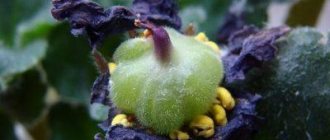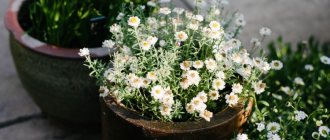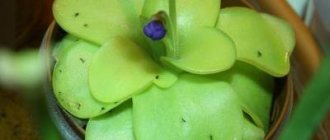Another one that arrived in our homes from the tropics is the homemade mimosa bashful. It attracts flower growers with its unusual properties. This very fragile and delicate gift of nature will not leave you indifferent. In this article you will learn a lot of interesting and useful information about mimosa pudica and its cultivation at home. You will become savvy and ready to successfully grow it in your home.
- Description of mimosa bashful
- Reproduction of mimosa pudica at home
- Pollinating mimosa flowers at home
- Propagation of mimosa by seeds
- Propagation of mimosa by cuttings
- Mimosa care at home
- Negative factors when growing mimosa pudica
Photo: Mimosa pudica on the windowsill.
Description and characteristics of mimosa
In the wild, this herbaceous crop grows in the hot tropics of America, Africa and Asia. At home, such a mimosa looks more like a shrub and can even grow up to 1.5 m, although usually lower. The plant has the following characteristics:
- erect stem with small thorns;
- the stem has leaves - 3-5 bipinnate groups that diverge in different directions;
- flowers with a diameter of no more than 2 cm are formed on the tips of the shoots;
- flower shape - round;
- color - pink-lilac shades.
Attention! The leaves of the plant fold at night or even with a light touch. But it is not advisable to play with them - this negatively affects the health of mimosa.
In indoor conditions, mimosa is grown as an annual. Propagation is carried out every year by cuttings or seeds. However, the shoots take root extremely difficult. Mimosa pollen is very small. People with corresponding allergies often react painfully to it.
Mimosa pudica flowers
Application in landscape design
Any floral arrangements in landscape design must correspond to the general idea. In everyday life, mimosa is often confused with certain types of acacias belonging to another genus from the Mimosa subfamily. Mimosa and acacia are surprisingly similar in appearance.
Most often, instead of mimosa, silver acacia or Acacia dealbata is used in decoration. Twigs of this particular flowering plant are traditionally given as gifts on International Women's Day.
Mimosa pudica or touch-me-not can be easily distinguished by touching it with your hand. The response to such a mechanical effect is the folding of all the leaves. The leaves can open only after half an hour or an hour. This protective property is a sure sign of mimosa.
Features of growing indoor mimosa from seeds
To get a full-fledged plant, it doesn’t matter whether you bought the seeds or collected them yourself from a fertilized flower. Pollination of mimosa should be done carefully. There are 2 ways:
- Arm yourself with a brush. Use this tool to transfer dust particles to another flower.
- Rub the mimosa flowers together a little.
Attention!
An external sign of successful fertilization in the photo and in person is the formation of the ovary and thickening of the tip of the stem. After a while, a seed pod is formed. In each of these, 6-10 pieces of mimosa seeds grow. The fruit can be picked when it is completely dry:
- Without opening, wrap the pod in plastic;
- place in the refrigerator at +5 ° C and store in this condition until spring;
- in March, remove and open the fruit. Inside there will be dark pea seeds with a diameter of about 2 mm;
- they need to be sown soon after being removed from the cold;
- Before planting, place the material in warm water for half an hour to further speed up the emergence of seedlings.
Mimosa pudica is sowed in a steamed peat substrate with an admixture of sand or in universal soil from the store. The structure of the soil should be loose and light. You don't need a large container - find narrow bowls with a hole in the bottom. Before filling the container with substrate, lay out an expanded clay layer for drainage.
Attention! Any soil for mimosa must be disinfected. The plant is capricious in this regard.
Step by step sowing goes like this:
- Moisten the soil well. Drain off excess moisture.
- Place the seeds on the surface, followed by a thin layer of the same soil or deepen them 1 cm.
- Cover the crops with film to keep heat and humidity at a constant level.
Flower propagation methods
The high demands on light, heat and moisture mean that not every exotic lover will agree to care for such a fastidious exotic all year round. It is much easier to grow a new seedling with the onset of spring. That is why mimosa pudica is most often used indoors as an annual plant.
Reproduction by cuttings
Trying to decorate their home with an exotic sissy, some gardeners are attempting to propagate it by cuttings. To do this, a cutting of a branch at least 20 cm long must be kept for 2-3 hours in a solution of root or potassium humate.
The cuttings prepared in this way are planted in moist, loose soil.
Note! Planting material can be covered with a large plastic cup or glass jar. The microclimate formed under the hood will give a greater chance that the first roots will appear in 2 weeks.
Propagation by seeds
In order for an unusual flower to settle forever in the collection of house plants, avid flower growers try to plant it with seeds every spring. This method of reproduction is considered the most effective because it gives good results.
Young shoots from seeds
It is enough to plant a seed in a moistened substance in early or mid-March and cover it with a small layer of soil. The planting container should be covered with polyethylene or a piece of glass, placing it in a warm place. In 2-3 weeks the first shoots will appear.
Caring for mimosa seedlings
The humidity under the mini-greenhouse film should always remain high. The temperature norm is +25…30 °C. Seedlings need to be ventilated once a day. When you remove the protection, water with a sprayer so that the water does not carry the seeds to the surface.
Under good conditions, seedlings can be expected in 2-4 weeks. After this, move the bowls to a sufficiently lit place, without abundant sun. The film can be removed. Humidity must be reduced without going to extremes. But the temperature will be the same as before emergence.
After 3 true leaves appear, the seedlings are ready for picking. For each, prepare a separate small pot. Place a drainage layer at the bottom. Fill the container with a substrate made from a mixture of peat, turf and leaf soil and sand (all in equal parts). Pots should also not be placed in direct sunlight.
Attention! Seedlings should be handled with extreme caution due to their fragile roots.
A useful plant?
The mimosa tree, sometimes called the Persian silk tree, is a legume and can help enrich the soil where it grows. The Persian name means "night sleeper" and in Japan it is known as the sleeping tree. This is because the leaves fold at night and during rainstorms. Instead of undivided leaves, they are separated, like a fern. The flowers, pale to dark pink, appear like fine threads of silk. They form small pods several centimeters long and contain seeds.
The technical name, Albizia julibrissin, is native to East and Southwest Asia, but is also found in the United States. It is a fast-growing ornamental tree that can reach over 9 meters in height. Among the advantages it is worth mentioning that they are quite resistant to cold weather. The crowns create good shade and smell delicious.
While these trees are beautiful and powerful, their impact on the natural environment can be problematic outside of their natural ecosystem. However, the severity of their effects remains controversial. The environmental threat is that the mimosa tree (photo can be seen later in the article) is a strong competitor to native trees and shrubs in open areas or forest edges. The dense walls of the mimosa significantly reduce the amount of sunlight and nutrients, making them unavailable to other plants.
Features of growing mimosa pudica
To ensure that the crop grows without problems, during the care process, try to take into account the following features:
- An adult plant loves the sun, so it is better to place it on a southern windowsill. In hot climates, make adjustments towards neighboring cardinal directions. In the shade, the mimosa will stretch out and lose its beauty. But even on the south side, the flower should be shaded from the midday sun.
- From March to October, maintain t +22…+24 °C. The rest of the time - about +17 °C.
- The optimal humidity for mimosa is not lower than 70%. Spraying or placing the pot in a tray with damp material helps maintain it.
- During the active growing season, water once every 2 days. The norm is the moist state of the top layer of soil. In winter, the volume of water should be reduced. Use soft filtered water.
- If, when watering or spraying, drops fall on the leaves, they can burn them.
- Twice a month in warm weather, the flower needs to be fed with mineral fertilizer complexes.
Proper care will give you beautiful mimosa blooms, which last from June for about 4 months. During this period, it is important that the air in the room is clean.
General information
Where does mimosa pudica grow?
On the Black Sea coast, the plant can reach 12 m in height in the form of a bush. Most often it can be found in the Caucasus, Abkhazia and Sochi. Previously, growing mimosa was only possible as a shrub in parks. Now it is so widespread that it grows on its own and no longer surprises anyone.
Interesting! In addition to Russia, mimosa is grown in Madagascar, Montenegro and France, on the coasts of Brazil and America.
Description of mimosa bush
Despite the variety of plant varieties, there is a general description that unites them:
- The crown consists of brown shoots with small cracks.
- The plant has a thorny trunk and small dissected leaves.
- Depending on the growing region, the first mimosa flowers may appear in mid-January.
- Mimosa flowers look like fluffy yellow balls.
Important! Flowering can cause inconvenience to allergy sufferers; you should be aware of this and do not grow such a plant at home.
Features of mimosa leaves
Every time you touch the foliage of the plant, it curls up, but after some time it regains its previous appearance.
This reaction also appears with the arrival of evening, especially if the temperature changes. If you shake a mimosa bush, it takes on a withered appearance, which also goes away over time.











